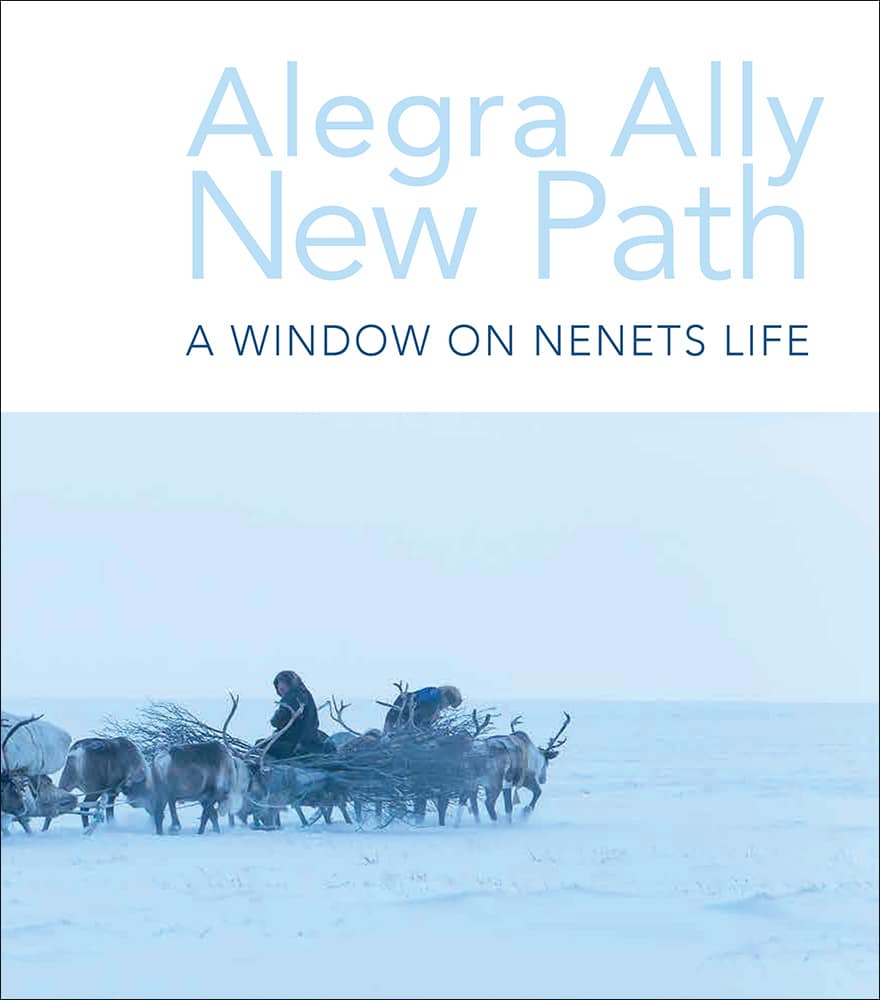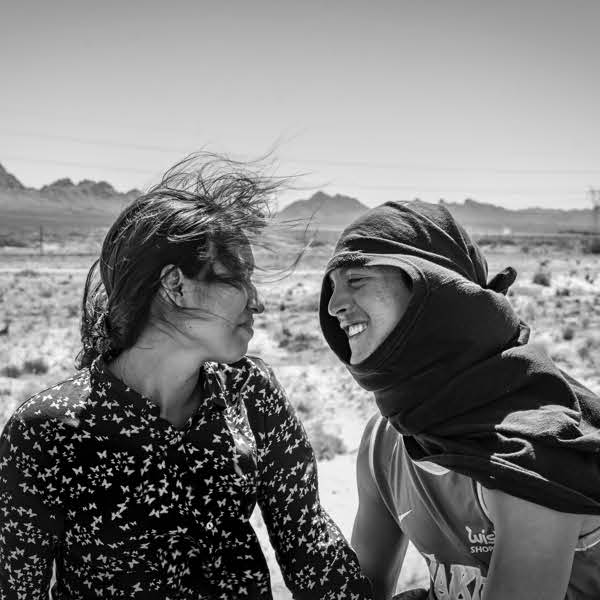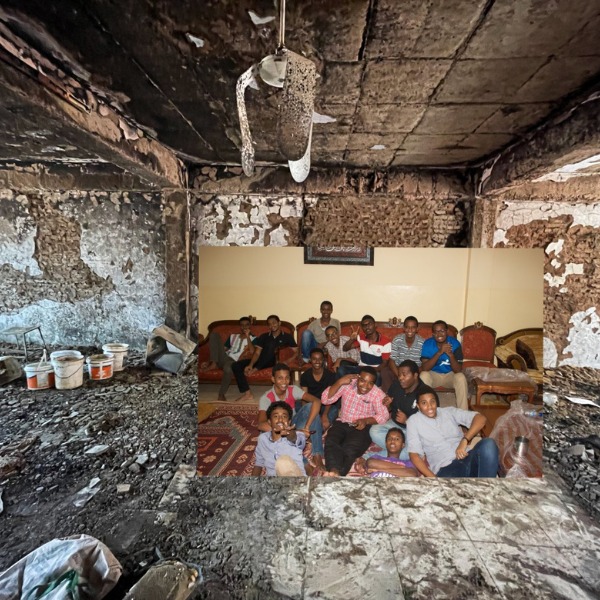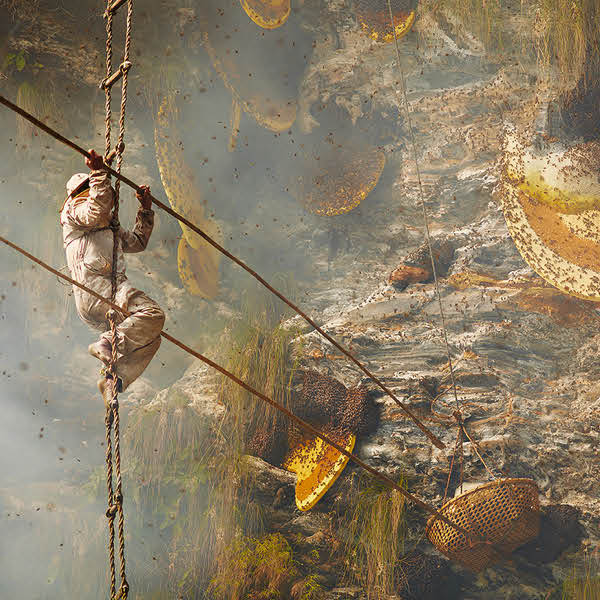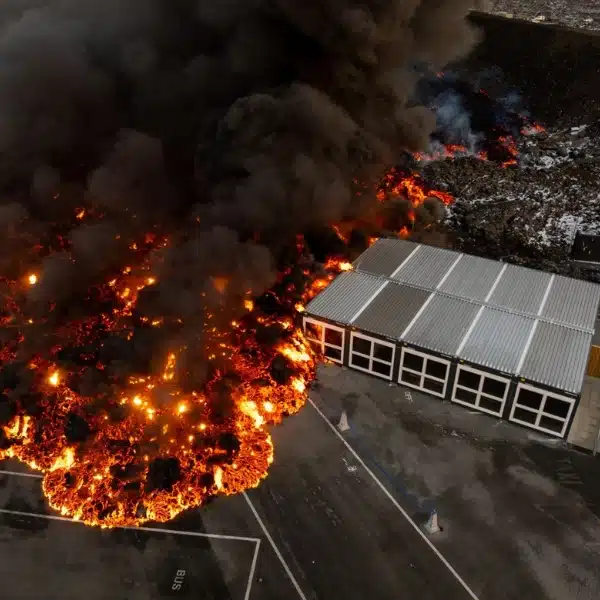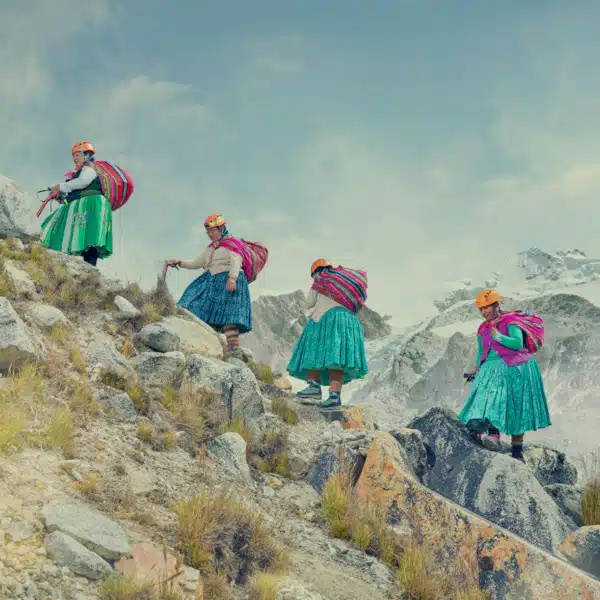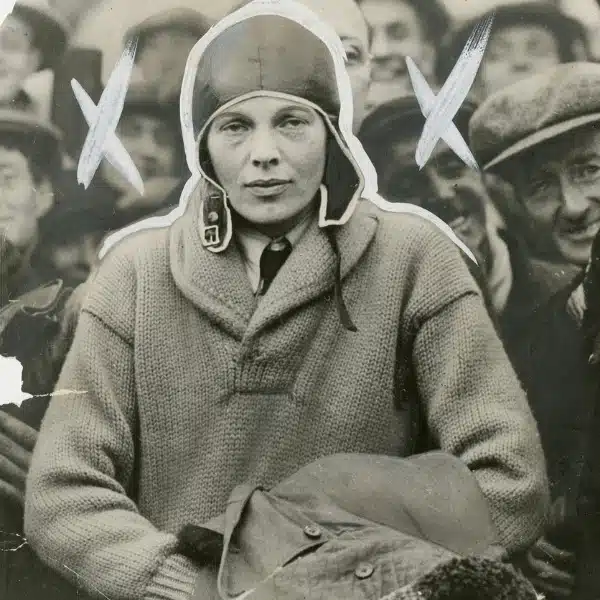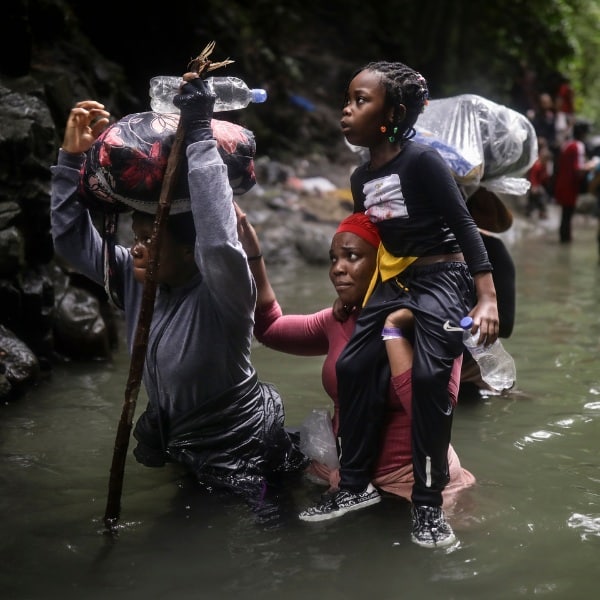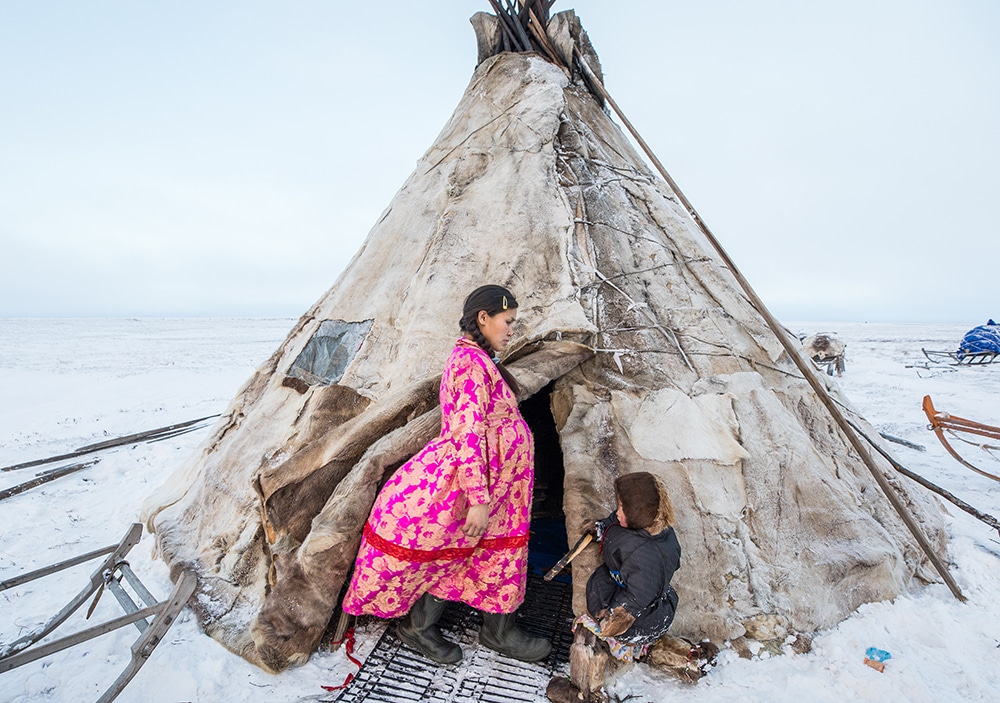
Lena and her daughter Christina are standing at the entrance of their chum. Lena’s large belly is obvious under her dress, and there is no doubt that she is nine months pregnant.
Since the 1960s, Nenets women have been instructed to leave their tundra homes to give birth in a hospital. Lena’s mother was the first in the family to give birth in a hospital. Lena’s grandmother, Praskovya, gave birth to five children in her tundra home, assisted by elderly women from neighboring chums who were experienced with births and served as midwives. It was after this time that air transport for pregnant women to the city hospital was introduced.
Documentary photographer Alegra Ally has dedicated her life to telling the stories of indigenous people around the world. Since she was a teenager, she has spent time with remote tribes in Papua New Guinea, the Philippines, Namibia, and now Siberia. Thanks to a successful fundraising campaign on Kickstarter, Ally was able to journey to the Yamal Peninsula and join a family of nomadic reindeer herders as they made their annual winter migration.
As a champion of women, Ally was especially eager to tell the story of a Nenets woman on a journey to motherhood. For this visual documentation, her time centered around Lena, who was about to give birth in the midst of a migration that calls for the Nentsy to travel thousands of miles toward the Arctic Circle. Immersed in the harsh conditions of Siberia, Ally joined Lena and her family as they continued to keep their culture's traditions alive.
The results of Ally's two-month stay with the Nentsy paints an incredible picture of adaptation and survival. As time moves forward, this group adapts without losing its identity. The Nentsy, like any culture, are constantly changing, though it may not seem immediately apparent. Snowmobiles work in tandem with traditional sleds (helping the group move more easily without compromising their spirit) and women like Lena often give birth at the hospital now rather than relying on the experience of elders acting as midwives. But within these changes, traditions still thrive with family members carrying out the chores and duties that have informed Nenets culture for thousands of years.
For a full look at Ally's time with the Nentsy, pick up a copy of her book, New Path—A Window on Nenets Life, published by Schilt Publishing. Read on for our exclusive interview with Ally, where she shares insider details about her experience with the Nentsy.

The sleds are an important aspect of the Nenets way of life. They are used for all aspects of their travel and migration, as well as for storage. There are at least two sleds designated for food storage. Like portable refrigerators, these sleds are used to store frozen meat, bread, butter, and other staples.
The chum must also be completely disassembled and packed onto the sleds before the family can begin their migration. Everything is tied tightly with rope and then covered by a waterproof layer of reindeer fur and skin and other waterproof sheets. Lastly, the reindeer are tied to the sleds.
Set in a line, the sleds form a caravan, with Lyonya at the front.
What initially drew you to this topic?
The Women at the End of the Land expedition was one among many I have undertaken as part of a larger initiative called The Wild Born Project. Since 2011, I have used ethical photography and ethnography to document the traditional practices and beliefs underlying the major life events of indigenous women. From early rites of passage, through to pregnancy, birth, and postpartum rituals, this world of women's experience and wisdom has been the inspiration and foundation for my work as an anthropologist and documentary photographer. It is my intention, through these expeditions, to create awareness and appreciation for traditional knowledge and practices, and to contribute to the revitalization of traditional ways of life for future generations.
I am also fascinated by human adaptation to the environment, and how the environment influences and shapes every aspect of our lives, not just in terms of practicality and survival—what we eat, how we dress—but also our belief system, our ways of life, our language and culture. I chose the Yamal Peninsula in Siberia because it is one of the world’s most extreme environments and particularly wanted to migrate with the Nenets during winter to experience and witness the Nenets way of surviving and adapting and thriving in the most challenging climates.

Lena (on the photo) lives with her husband Lyonya, their four-year-old daughter Christina and their three dogs, Khutyu, Khadak and Tewa.
Finding Lena, a nomadic Nenets woman who was close to giving birth, was a challenge for photographer and ethnographer Alegra Ally. The journey with Lena and her family took many unexpected turns. Lena gave birth during an extremely challenging season where winter migration did not go as planned. The birth saga came to be emblematic of the Nenets’ struggle to keep their cultural heritage and highly adapted way of life intact in this modern age.
How did you connect with the family that you stayed with and what was the experience of gaining their trust like?
Planning this expedition logistically was complex, and required research and planning for a year prior to my departure. The Yamal peninsula is remote and accessibility is challenging. More so, the Nenets are on a constant move and very difficult to reach. I had to work with a local fixer who is known amongst Nenets families. My fixer had to reach out to various camps and ask whether any of them had a woman who was due to give birth during winter.
Once a woman was found, we needed to verify that the family was willing to take me along with them—not an easy decision for Nenets families as it might be considered a burden, as the winter months are when the family is more in survival mode, fighting the elements and also short on essential supplies such as water and wood. The fact that a family accepted me into their midst is something I appreciate greatly. The winter journey with the family fostered closeness and intimacy between us, which I believe we will cherish for the rest of our lives.
I think there is a universal law between hosts and guests. Respecting boundaries and being sensitive to their culture was essential. I constantly felt humbled by their generosity and sharing and it made me be constantly grateful.
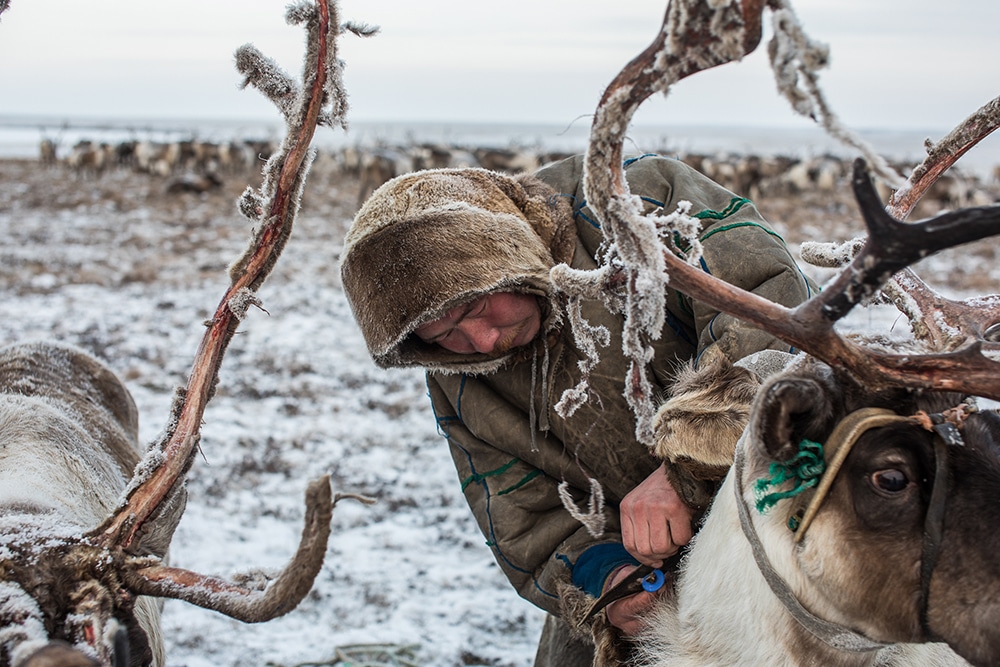
For thousands of years, indigenous Nenets have led nomadic lifestyles, migrating with their reindeer herds across the Yamal Peninsula in the Russian Arctic. The Khudi family is one of 12,000 Nenets still migrating along the same routes as their ancestors did for centuries.
Unfortunately, because of the climate change, which harshly affects weather conditions in the tundra, thousands of reindeer died of starvation in the Yamal Peninsula two years ago. Lyonya explains, “We had rain in the middle of February, which turned the tundra into a sheet of ice. Our reindeer suffered because they couldn’t dig the ice to get lichen. That year my uncle lost more than 400 reindeer.”
It was a difficult winter that you encountered. What did this teach you about the character of the Nenets and their resilience?
The Nenets are masters of adaptation and we can all learn from them about resilience. Learning how to survive in the world’s harshest climate and how to use every resource they have for survival while thriving is admirable. Being so adaptable has gifted them with the ability to know how to balance their lives so accurately and these abilities translate to other aspects of their lives.
So, when progress was introduced into their lives, they managed a balance that enabled them to decide what they need in order to complement their lives versus how much they can consume and lose a big part of their identity and culture. I think that the Nenets are a riveting example of the merging of both worlds and how to be proud of cultural identity along with progress.
The Nenets did not stop being Nenets when they began to use snowmobiles as transportation to replace their ancient wooden sleds. They did not abandon their nomadic lifestyle, following their ancestors as they lived for thousands of years when they introduced motorized snowmobiles. But it is our myopic approach to ethnocentrism and how it defines our actions as a means of power and domination over other societies. These are societies that are overwhelmed by powerful external forces beyond their capacity to adapt to, and the results are that, in this way, they are being forced out of existence.

During the change of season from autumn to winter, the vast tundra of the Yamal Peninsula is transformed into an icy landscape covered in snow and interlaced with frozen rivers and lakes. This transformation allows the Nentsy to migrate with their sleds and reindeer herds across the tundra for thousands of kilometers, following their ancient migration route to their winter camps.
In autumn 2016 winter was late to arrive, and the absence of snow made it impossible for the Khudi family to begin the migration. Uncommonly warm temperatures and unstable weather patterns that have temperatures rising and falling dramatically created a muddy wetland that is unstable and treacherous for the reindeer to traverse. The waterlogged soil is also bad for the vegetation, particularly the lichen that grows here, which is starting to deteriorate. The lichen is the primary food source for the reindeer, and the reindeer are the reason for the Nenets way of life.
Climate change has a strong impact on the Nentsy, their herds, their migration, and their adaptation to the new reality.
(continued) I believe it is very important to understand the reality that many indigenous societies are facing, including the Nenets, and that change is inevitable, and that change is not always a threat to culture.
In the eight weeks I spent living with the Khudi family in the Yamal Peninsula, the fragility of the environment and the Nenets' way of life there was revealed to me. In this time, the winter migration was postponed six times due to unpredictable weather patterns and climate fluctuations that presented a critical lack of snow coverage on the tundra. These conditions not only impacted the Nenets ability to move their herds, but also threatened the herd's food supply itself.
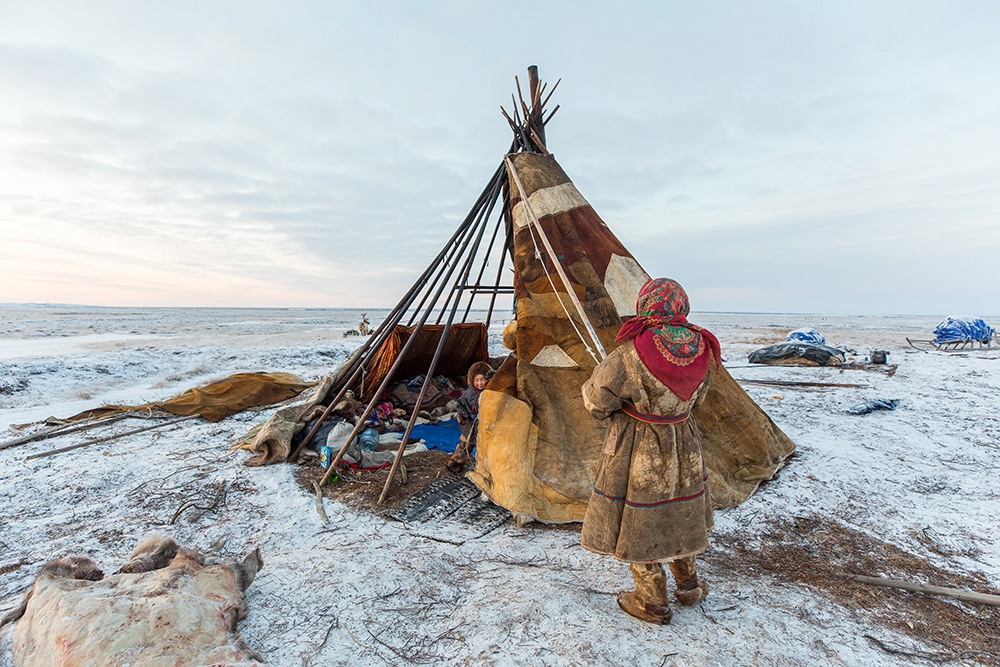
A huge part of the Nentsy’s adaptation to life on the tundra lies in the ingenious design of the chum, the traditional tepee structure that they live in.
Withstanding frost, heavy snowstorms, and strong winds, it keeps the family safe and comfortable in all imaginable elements. The chum we stayed in is made up of twenty-two pine poles and is adapted to the different seasons on the tundra through the coverings used on the outside and the flooring laid out on the inside. There is a gap at the top for ventilation and to allow smoke to escape. In spring and summer, there are two layers of felt fabrics enclosing the structure. In autumn the chum is covered with two layers of reindeer skin and fur, each layer stitched from between twenty-five and forty skins. The flooring of the chum in summer is usually a thin plastic layer, in winter this is covered by wooden flooring, which is often layered again with reindeer furs.
Did you have a specific creative plan in mind going into the experience? And how did that change as the adventure developed?
Although every expedition I plan has a vision and goals, the nature of my work usually results in shifts and unexpected turns. For example; in Siberia, the element of climate change became a dominant part of the story. Initially, my plan was to migrate with the family several times during the 60 days.
I arrived in late autumn and temperatures at this time of the year should have been at least 15 degrees lower, and snow should have been covering the tundra by then. Unfortunately, that year, temperatures were unusually high during summer, which meant that during the seven weeks I was with the Nenets family, our winter migration was canceled six times. So instead of photographing their migration, I photographed the family and their reindeer on patches of muddy soil. Eventually, winter arrived, and with it the freezing temperatures, but at that point, the mud froze which resulted in very difficult terrain to navigate with a sled.
My journey with Lena and her family took many unexpected turns. Lena did give birth while I was with the family during an extremely challenging season where winter migration did not go as planned. The birth saga came to be emblematic of the Nenets' struggle to keep their cultural heritage and highly adapted way of life intact in this modern age.
Through offering a rare glimpse into a way of life that exists upon a rapidly changing landscape, I hope to provide an understanding of the inherent changes that both enrich and threaten the Nenets' collective identity as nomadic reindeer herders.
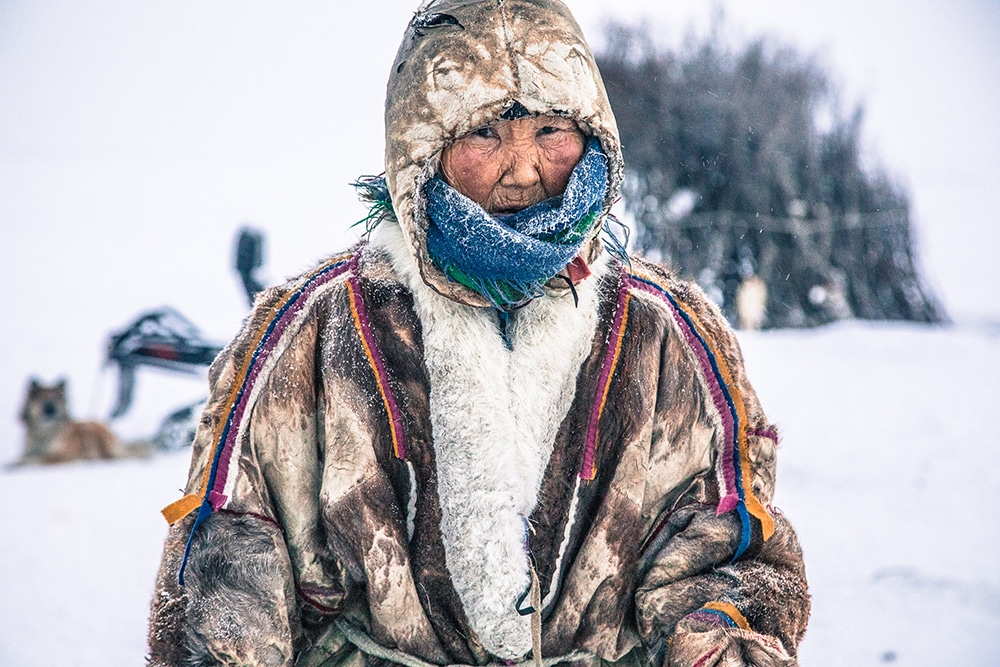
Praskovya is 96 years old, and the oldest Nenets grandmother living on the tundra. Even at 96, her age does not stop her from spending many hours outside, helping with the herd, and cutting firewood.
In particular, she loves her Laika working dogs and is very affectionate with them. She is also a great storyteller, sharing her stories with the family, passing on words of wisdom, and knowledge she has gained. The stories she tells are oral textbooks, containing lessons, ideas, and guidance on how to protect, respect and preserve the connection the Nentsy have with their land, culture, and values.
Can you talk about the impact—both emotional and physical—of living in that extreme cold?
In the framework of an ethnographer, my goal is to immerse myself in the ways of life of the people I visit. Yet, nothing could quite prepare me for the harsh Arctic conditions which added an even bigger admiration to the resilience of the Nenets. It is truly a place where one must “expect the unexpected” and it is one of my biggest lessons of living in the Tundra amongst the Nenets. I was equipped with the best arctic clothing but at some point, the only clothing which kept me warm was the local dresses made from reindeer skins.
I have started working in remote locations two decades ago and each time I arrive in a new place I have to adapt to a new environment, as well learning a new set of local beliefs and rules. I’ve learned to balance myself with time which is based on the experience of knowing that I need to allocate time for adjustment, getting to know the culture, the people, and the challenges the environment brings.
My main challenges are both physical and physiological. One big challenge, which people often are not aware of, is loneliness. It is a complicated issue, but learning to embrace it and not resist allows for immense personal growth. I can say that I mostly enjoy the challenge and appreciate it. It's partially what gives the experience its intensity and its depth of learning and growth—easier said than done while on the field.
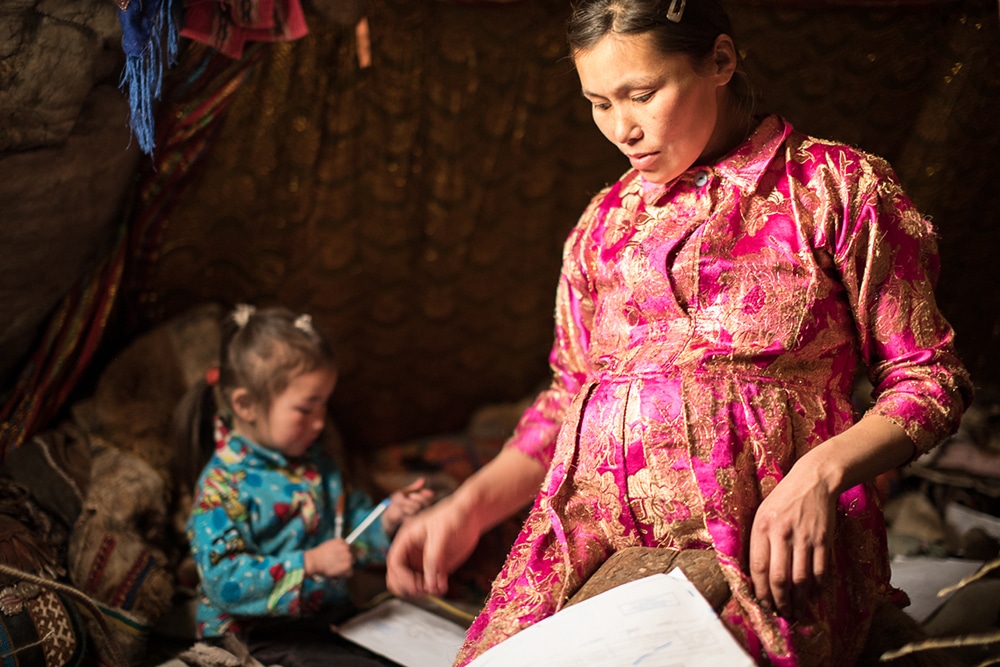
In the Nenets culture, all jobs inside the chum, including all of the house-keeping, cooking and taking care of the children and the dogs, are done by women, while men’s responsibilities are with the herd. Men are prohibited from doing any of the women’s work.
In her free time, Lena sews and decorates boots, gloves and winter apparel using dried reindeer sinew as thread. Four-year-old Christina accompanies Lena as she goes about all of her daily chores and tasks. The bond between a mother and a daughter is very strong, especially given that the family lives in relative isolation from other families, a fact that defines much of the Nentsy’s unique identity.
What do you admire most about Lena and what do you hope that people take away from her story?
There are so many things I admire in Lena. As a mother, a wife, and a woman, and as a host. I think what has made me constantly be in awe is her ability to complete all life aspects but in the harshest and most hostile environment on our planet. Every aspect which to us—people who live in the developed world—seems easy and comfortable requires extra challenges and difficulties for Lena.
As someone who is responsible for the household, simple acts such as pouring water for food, drink, and washing means walking long distances in snowstorms in minus 50 degrees, breaking large ice blocks with an ax, walking home with them, melting them in a pot, and then using them—using everything in an efficient way and not wasting a thing because what is there is limited and requires a lot of energy to obtain again. For all the hardship, Lena did not express any desire to change her way of life. We discussed the challenges of being a Nenets woman but Lena is very proud of being a Nenets and doesn’t want to change the way she lives.
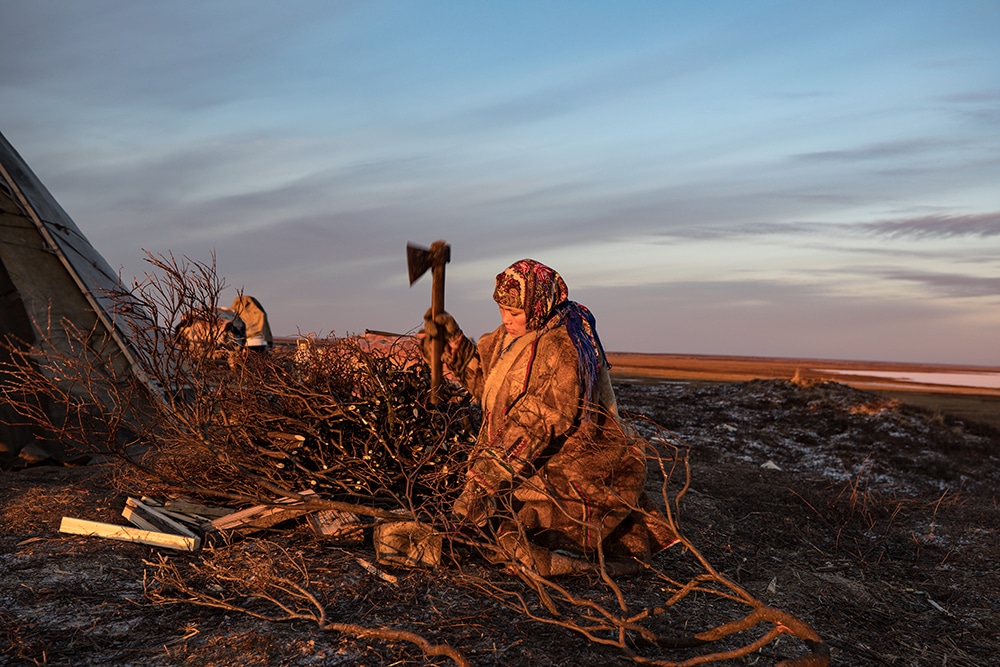
The most basic aspects of survival, such as keeping warm, requires constant tending to here on the tundra. Cutting firewood to keep the fire burning, or using an ax to break the ice to fetch water for cooking and drinking, are daily tasks that must be done in all kinds of weather, including snowstorms and temperatures of -40 to -50°C.
For the Nentsy, most of these daily tasks for survival and comfort are the responsibility of women in the family, whereas the men tend to the herd. Lena is nine months pregnant but she still follows her daily patterns and fulfills the tasks she is responsible for.
(continued) As an ethnocentric society, we have this idea that the world should evolve to become the model of our reality. That all societies should become us. This model that values progress through achieving advanced technology, which comes at the expense of our environment—a society that views itself as superior to nature, and devalues anyone who does not have similar achievements or concepts about industrialization and capital.
Living alongside indigenous people like the Nenets amplifies the idea in which there isn’t one right model of reality and that there are many ways of existing, of being in the world. None of them is more or less of an “ideal.” Cultural diversity is our only hope for keeping the human spirit alive. To keep us as a social species with the desire to travel, to learn and adapt, to create, and to be inspired. The fact that the Nenets learned to thrive in the most rigid and harsh environment on our planet is here to show us that without human imagination and the passion to pursue our dreams, humans will not be able to adapt to live in the most extreme environments and find ways to coexist with nature.
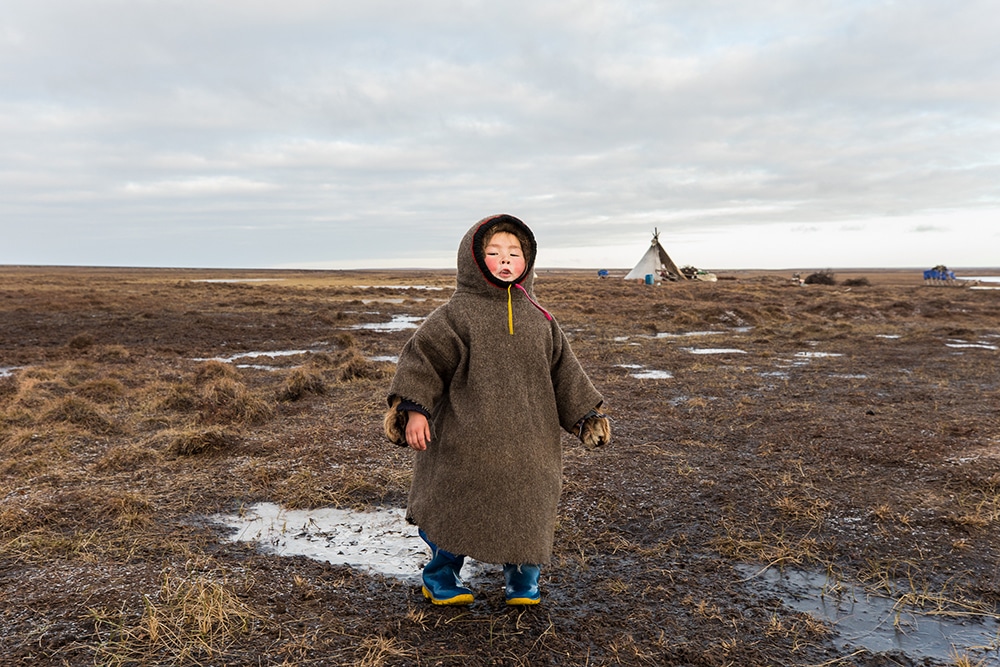
For the four-year-old Christina, the vast open landscape of the tundra in autumn is her playground, and she makes a game of breaking the thin ice that forms over the pools of water. Gradually as the winter comes, the air becomes crisper and temperatures begin to drop consistently. The layers of ice begin to thicken and Christina finds great joy in rolling on the thick frozen ice.
The extreme weather conditions due to climate change were unfamiliar to the Nentsy until recently, and have also had an impact on the people’s health in the tundra. When temperatures suddenly change from -5 to -35°C in a matter of days, it puts a tremendous strain on the human body. During this period of erratic weather, Christina experienced multiple nose bleeds, and one herder collapsed.
What's next for you?
In the evolution of the Wild Born Project, I have now launched what was years in the making—Adventurous Midwives, a non-profit organization registered in Australia that will further and deepen the work on the Wild Born Project. I was looking for more meaningful ways to develop long term relationships with the indigenous women who I am working with and to create relationships that will help foster and make a positive change in their lives.
Adventurous Midwives supports the health and survival of indigenous mothers and their babies through collaborative initiatives in midwifery and holistic health that create opportunities for the cross-cultural sharing and revitalization of midwifery knowledge.
We have launched the 2020 passage expedition to Papua New Guinea. I have long waited to return to the place where it all began with the Kosua tribe and now I will return with a group of midwives. We aim to create a global movement of midwives who engage in respectful, collaborative cross-cultural learning and exploration in indigenous communities, nurturing the continued health, vitality, and survival of indigenous women and their babies through revitalization of oral traditional midwifery knowledge and practice, and the provision of care that addresses the self-identified needs of these women.
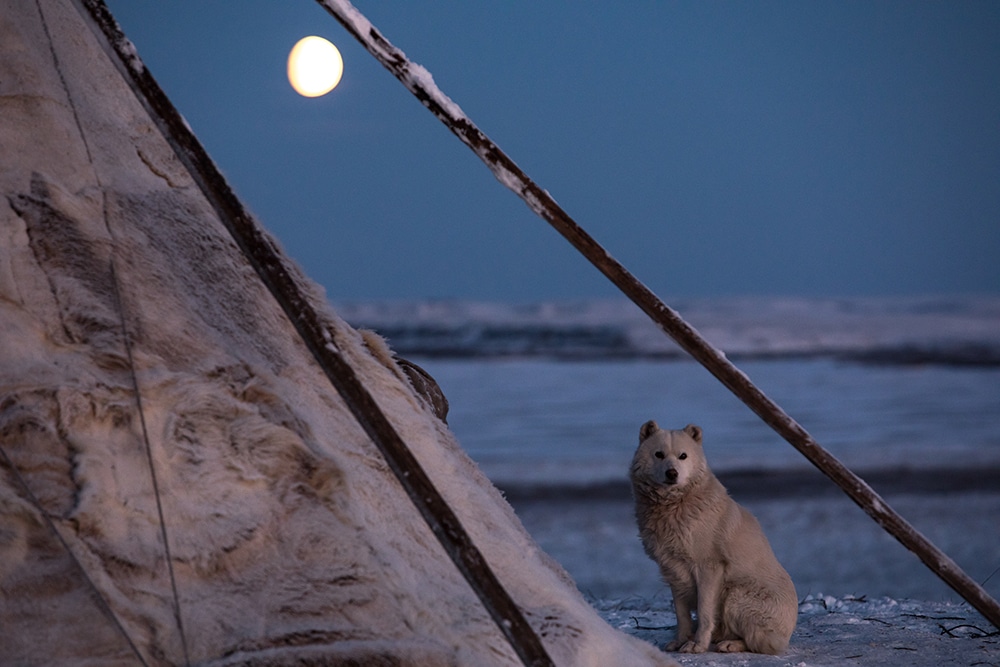
The dogs are treated like family in the Nentsy culture. Lena and her husband Lyonya have a herd of 800 reindeers and three, who are an essential part of herding reindeer.
The Nenets rhythm of life is determined by their herds. It is the reindeer’s pasturing needs that set the movement of their human owners in motion, but it is the humans who lead the migration across the tundra. While the men are lassoing the herd, women help by keeping the herd together. For several hours, Lena’s role is to circle the herd over and over again with one of the dogs at the end of a long leash until the lassoing is finished. Circling a herd of about 800 reindeer is a big distance to cover, and the dogs bark and try to run, pulling at the leash enthusiastically, making Lena work even harder to control them. It is extremely tiring and physical work that requires constant attention.
(continued) Through ensuring indigenous women’s voices are heard and their needs met, the health, well-being, and prosperity of the whole community is nurtured. Through journeys that offer immersive cultural experiences and opportunities to build collaborative relationships with the participating communities, we aim to offer practicing midwives, holistic practitioners, and researchers an opportunity to learn about traditional knowledge and practices from indigenous midwives and support indigenous women in their communities to provide ongoing safe health care.
Through this unique exchange, we aim to support indigenous women in providing their families and communities with safe midwifery practices that complement—not replace—their own knowledge and practices. We believe much can be learned from traditional midwives. They are the keepers of vast ecological knowledge, stories, belief systems, ceremonies and prayers within their communities, and are responsible for supporting mothers as they bring their babies into the world. We are here to learn, share knowledge and co-create programs with these women. Our programs provide birthing kits where applicable, offer opportunities for midwives to share and learn from one another, and provide holistic midwifery curriculum and care from participating practitioners from around the world.
